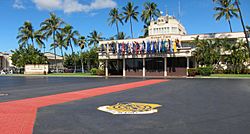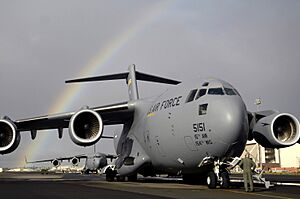Hickam Air Force Base facts for kids
Quick facts for kids Hickam Air Force Base |
|||||||||||||||||
|---|---|---|---|---|---|---|---|---|---|---|---|---|---|---|---|---|---|
| Honolulu, Hawaii in the United States of America | |||||||||||||||||

The historic base operations building (DV1)
|
|||||||||||||||||
| Coordinates | 21°19′07″N 157°55′21″W / 21.31861°N 157.92250°W | ||||||||||||||||
| Type | US Air Force Base | ||||||||||||||||
| Site information | |||||||||||||||||
| Owner | Department of Defense | ||||||||||||||||
| Operator | US Air Force | ||||||||||||||||
| Site history | |||||||||||||||||
| Built | 1938 (as Hickam Field) | ||||||||||||||||
| In use | 1938 – 2010 | ||||||||||||||||
| Fate | Merged in 2010 to become an element of Joint Base Pearl Harbor–Hickam | ||||||||||||||||
| Airfield information | |||||||||||||||||
| Identifiers | IATA: HIK, ICAO: PHIK, FAA LID: HIK | ||||||||||||||||
| Elevation | 3.9 metres (13 ft) AMSL | ||||||||||||||||
|
|||||||||||||||||
Hickam Air Force Base was a special place for the United States Air Force (USAF) in Hawaii. It was named after a brave pilot, Horace Meek Hickam. In 2010, Hickam Air Force Base joined with Naval Station Pearl Harbor. Together, they formed a new base called Joint Base Pearl Harbor–Hickam. This base is on the island of Oʻahu in Hawaiʻi. It is next to Daniel K. Inouye International Airport and shares its runways.
Contents
Air Force Units at Hickam
Hickam Air Force Base was home to many important Air Force groups. The main group was the 15th Wing (15 WG). Many other units worked alongside them. These included the main office for Pacific Air Forces (PACAF). The Hawaii Air National Guard and its 154th Wing (154 WG) were also there.
The Air Mobility Command's 515th Air Mobility Operations Wing (515 AMOW) helped move people and supplies. They used large planes to fly across the Pacific Ocean. Hickam also supported about 140 other smaller units.
The 15th Wing had four main parts, each with a special job:
- The 15th Operations Group (15 OG) managed all flights and airport activities.
- The 15th Maintenance Group (15 MXG) kept aircraft and ground equipment working.
- The 15th Mission Support Group (15 MSG) handled many tasks. These included security, building care, communications, and helping personnel.
- The 15th Medical Group (15 MDG) provided health and dental care.
Some flying units at Hickam included:
- 535th Airlift Squadron (flying C-17 Globemaster III planes)
- 65th Airlift Squadron (flying C-37B planes)
- 19th Fighter Squadron (flying F-22 Raptor planes)
Some of these squadrons worked closely with the Hawaii Air National Guard. They shared missions and equipment.
History of Hickam Air Force Base
How Hickam Air Force Base Started
In 1934, the Army Air Corps needed a new airfield in Hawaii. The old one, Luke Field, was too busy. So, they bought a large area of land near Pearl Harbor. This land was once covered with trees and sugar cane fields. It cost over a million dollars, which was a huge amount back then. It was the biggest military building project of its time.
The new airfield was named after Lieutenant Colonel Horace Meek Hickam. He was a famous pilot who died in a plane crash in 1934. Building the base was a big job. It was officially opened on September 15, 1938.
The main building was a huge barracks, like a giant hotel. It had three floors and nine wings. It could house 3,200 men and had everything they needed. This included barber shops, a medical clinic, and a large dining hall. Soldiers started moving in by 1940.
Hickam became the main Army airfield in Hawaii. It was the only one big enough for the large B-17 Flying Fortress bombers. By December 1941, the Hawaiian Air Force had many planes and soldiers ready.
Hickam During World War II
On December 7, 1941, the Imperial Japanese Navy attacked Oahu. Their planes bombed Hickam Air Force Base. They wanted to stop American planes from fighting back. Hickam was badly damaged. Many planes were destroyed, and 189 people died. Over 300 were injured.
Nine firefighters from Honolulu were also hurt or killed while fighting fires at Hickam. They were later given Purple Heart medals. This was a very rare honor for civilian firefighters.
During World War II, Hickam became a vital center. Pilots were trained there, and aircraft were put together. It was also a key stop for planes flying across the Pacific. These planes carried troops and supplies. They also brought wounded soldiers back home. This important role earned Hickam the nickname "America's Bridge Across the Pacific." It played this role again during the Korean and Vietnam wars.
Hickam in the Cold War Era
After World War II, Hickam continued to be a major air transport base. It supported important missions like the Apollo space flights in the 1960s and 1970s. It also helped bring American prisoners of war home from Vietnam in 1973. Later, it helped move thousands of orphans and refugees from Southeast Asia in 1975.
In the early 2000s, Hickam started getting new transport planes. These were the C-17 Globemaster III aircraft. The first C-17 arrived in 2006. These planes were flown by the 535th Airlift Squadron.
On September 16, 1985, Hickam Air Force Base was named a National Historic Landmark. This recognized its important part in World War II. You can still see bullet holes on some buildings from the 1941 attack. The American flag that flew over the base that morning is also on display. Its bullet-scarred walls remind everyone to always be ready.
Notable Accident
On March 22, 1955, a United States Navy plane crashed near Oahu. It was trying to land in bad weather. All 66 people on board died. This was the worst plane crash in Hawaii's history at that time.
Geography of Hickam Air Force Base
Hickam Air Force Base covers about 2,850 acres (11.5 km2) of land. This land is worth over $444 million. It is located next to Pearl Harbor Naval Shipyard and the Pearl Harbor entrance channel. Fort Kamehameha is to its south, and the airport is to its east.
The main entrance to Hickam is on Nimitz Highway. This highway connects to Honolulu. The homes for people working at the base are in an area called Hickam Housing.
See also
 In Spanish: Base de la Fuerza Aérea Hickam para niños
In Spanish: Base de la Fuerza Aérea Hickam para niños


